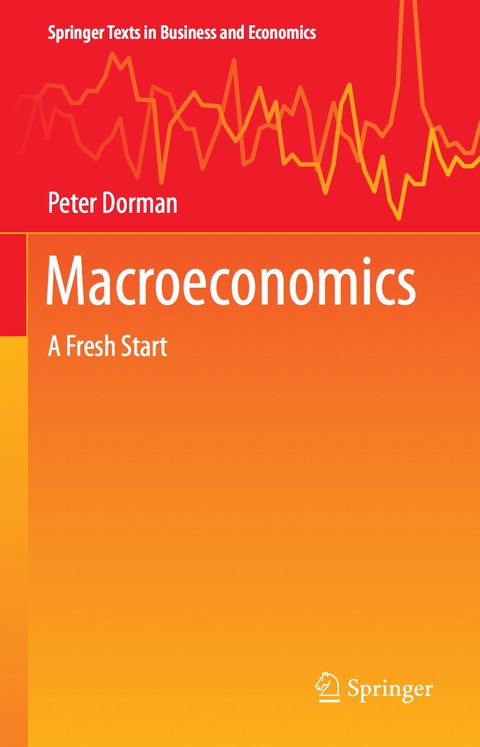Description
Efnisyfirlit
- Acknowledgements
- Contents
- Part I: Background
- 1: Introduction: Economic Growth and Development in Historical Perspective
- 1.1 The Long View
- 1.2 Accounting for Growth
- 1.3 Development as Well as Growth
- 1.4 Theories of National Economic Development
- Reference
- 2: Some Relevant Microeconomics
- 2.1 Why Micro and Macro?
- 2.2 The Core Assumptions of Microeconomics
- 2.3 Supply and Demand Analysis
- 2.4 The Normative Interpretation of Markets
- 2.5 Market Failure
- 2.6 Economic Institutions
- 2.7 General Equilibrium Theory
- Part II: The Terrain of Macroeconomics
- 3: Accounts and Measurements
- 3.1 The Circular Flow of Income and Credit
- 3.2 The National Income and Product Accounts
- 3.3 Flow of Funds Accounts
- 3.4 The Balance of Payments Accounts
- 3.5 Economic Measurement and Human Well-Being
- 4: The Fundamental Macroeconomic Identities
- 4.1 NIPA and the Relationship of the Parts to the Whole
- 4.2 Financial Balances and Trade
- 5: Macroeconomic Issues: Output, Employment, Inflation, Stability
- 5.1 Output
- 5.2 Employment
- 5.3 Inflation
- 5.4 Financial Stability
- 6: Macroeconomic Adjustment
- 6.1 Varieties of Adjustment
- 6.2 Adjustment to Reduce Inflation: The Case of the United States, 1978-1982
- 6.3 Adjustment to Raise Income and Employment: The Case of the United States, 1982-1983
- 6.4 Adjustment to Overcome a Financial Crisis: The Case of Argentina, 2001-2002
- 6.5 Some Observations About Adjustment
- 7: An Introduction to Money, Banks and Financial Systems
- 7.1 Why Societies Create Money
- 7.2 Money and Liquidity
- 7.3 Measuring Money
- 7.4 Banks: Private Profit and Public Function
- 7.5 Banks as Guardians and Creators of Money
- 7.6 How to Make Money: A Step-by-Step Guide
- 7.7 An Overview of the Financial Industry
- 7.8 Central Banks
- 7.9 The Paradox of Risk
- 8: International Finance: A World of Many Moneys
- 8.1 The Rise and Fall of the Gold Standard
- 8.2 The Retreat from Gold: The Gold-Dollar Standard of Bretton Woods
- 8.3 Floating Exchange Rates and Foreign Exchange Markets
- 8.4 The Role of Reserve Currencies
- 8.5 International Financial Instability from 1982 to the Present
- 9: International Trade in an Interdependent World
- 9.1 Introduction: Disaster and Disruption in an Interconnected World
- 9.2 Patterns of International Trade
- 9.3 What Is International Trade?
- 9.4 Mercantilism, Liberalism and the Debate Over Trade
- 9.5 Ricardo´s Theory of Comparative Advantage in International Trade
- 9.6 Friendly Amendments to Ricardo´s Theory of International Trade
- 9.7 Limitations of Standard Trade Theory
- Part III: Macroeconomic Theories in Conflict
- 10: Classical Economics and the Keynesian Challenge
- 10.1 The Classical View of Output and Employment
- 10.2 The Keynesian Challenge
- 11: Equilibrium National Income and Financial Balances in a Keynesian World
- 11.1 Step 1: The Consume Everything Economy
- 11.2 Step 2: Add Savings
- 11.3 Step 3: Add Investment
- 11.4 Step 4: Add Taxes and Government Spending
- 11.5 Step 5: Add Imports and Exports
- 11.5.1 A Word on Macroeconomic Models
- 11.5.2 Equilibrium National Income and Financial Balances
- 12: Keynesian Fiscal Policy
- 12.1 The Political Economy of Keynesian Fiscal Policy
- 12.2 The Economic Basis of Keynesian Fiscal Policy
- 12.3 Taxes or Spending?
- 12.4 Autonomous Versus Discretionary Fiscal Policy
- 12.5 Should the Government Try to Balance Its Budget?
- 12.6 How Large a Deficit?
- 12.7 Fiscal Space
- 13: Central Banks and Monetary Policy
- 13.1 The Purposes of a Central Bank
- 13.2 The Wizard´s Wand: Open Market Operations
- 13.3 Monetary Policy Principles
- 13.4 Monetary Policy Versus Fiscal Policy
- 13.5 Monetary and Fiscal Policy Together
- Appendix: The IS-LM Model
- 14: Business Cycles
- 14.1 Some Empirical Evidence
- 14.2 Investment Cycles
- 14.3 Policy Cycles
- 14.4 Financial Cycles
- 14.5 Summing Up
- 15: The Crucible of the 1970s
- 15.1 The Life and Times of the Keynesian Consensus
- 15.2 Resistance to Keynesian Policy at the Beginning of the 1970s: Monetarism
- 15.3 The Role of Time in Economic Models
- 15.4 Adaptive Versus Rational Expectations
- 15.5 From Market Failure to Government Failure
- 15.6 Rethinking Unemployment
- 15.7 Stagflation and the Counterrevolution in Economic Theory
- 15.8 The Short Run Phillips Curve and the Natural Rate of Unemployment
- 16: The Rise and Fall of the Great Moderation
- 16.1 What´s Moderate About the Great Moderation?
- 16.2 Splitting the Difference: The Short Run and the Long Run
- 16.3 Macroeconomic Modeling During the Great Moderation
- 16.4 Policy Precepts During the Great Moderation
- 16.5 Teaching the New Macroeconomics: The Aggregate Demand-Aggregate Supply Model
- 16.6 Using AS-AD: Supply Shocks, Policy Shocks and the Problem of the Long Run
- 16.7 Against the Grain: Keynesian Dissent from Mainstream Macroeconomics
- 16.8 The Great Moderation in Retrospect
- 17: The Financial Crisis of 2008 and Its Aftermath
- 17.1 The Great Unbalancing
- 17.2 Finance on the Brink
- 17.3 The Meltdown
- 17.4 Crisis Management
- 17.5 The Problems Continue
- 17.6 Crisis in the Eurozone
- 17.7 Did Economics Fail the Test?
- References
- Glossary
- Index






